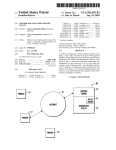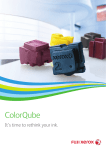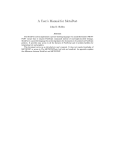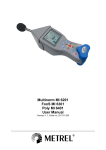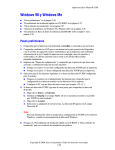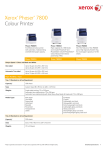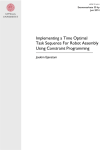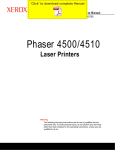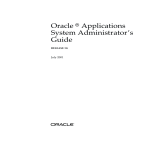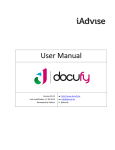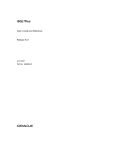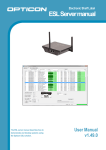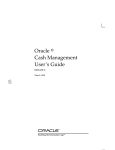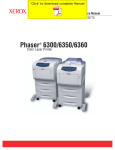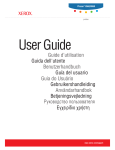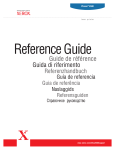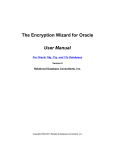Download System and method for automated printer diagnostics
Transcript
US 20030110412A1 (19) United States (12) Patent Application Publication (10) Pub. No.: US 2003/0110412 A1 (43) Pub. Date: Neville (54) SYSTEM AND METHOD FOR AUTOMATED PRINTER DIAGNOSTICS (75) Inventor: Russell S. Neville, Wilsonville, OR (Us) (52) (57) Jun. 12, 2003 US. Cl. .............................................................. .. 714/25 ABSTRACT Correspondence Address: A support system for diagnosing printer problems, includes Patent Documentation Center Xerox Corporation a support server and a printer located remote from the support server. The support server includes a rules engine for Xerox Square 20th Floor parsing printer diagnostic data into components, for analyZ 100 Clinton Ave. S. ing the components and for generating a suggested solution Rochester, NY 14644 (US) based on combinations of printer diagnostic data and error conditions. The printer includes a printer driver, responsive (73) Assignee: Xerox Corporation to a user request for support, for communicating With the (21) Appl. No.: 09/886,325 (22) Filed: Jun. 19, 2001 support server. Printer diagnostic data may be generated by a usage pro?le utility resident at the printer or by doWn loading a printer diagnostic utility from the support server, Publication Classi?cation or a combination of both. Generated printer diagnostic data is sent to the support server Where the rules engine parses (51) Int. Cl? ..................................................... .. H04B 1/74 and analyZes the received data and generates a suggested solution for transmission to the printer. / l2 l6 PRINTER / '4 SUPPORT SERVER RULES ’ '5 ENGINE DIAGNOSTICS UTILITY PRINTER PRINTER / '4 VW Patent Application Publication Jun. 12, 2003 Sheet 1 0f 7 US 2003/0110412 A1 59:3 5 % 2 3K5 : “Hz-E .QE ~ Patent Application Publication Jun. 12, 2003 Sheet 2 0f 7 3LT 2‘ \ w 5 2 5 5 :L:$\52 \;_m§a;s_m_ a§\$MI50am:2s; H31K@+N\ \ m\\a\?z : -.\“2 58 5E 82 US 2003/0110412 A1 Patent Application Publication Jun. 12, 2003 Sheet 3 0f 7 US 2003/0110412 A1 PRINTER /l4 54 FORM CALL 56 DIAGNOSTICINFD USER SELECTS DIALOG SUPPORT BOX \50 HTTP SUPPORT 108 ' \52 mm \Im SUPPORT —> SUPPORT ‘__I csA REuuEsT <_-_ sERvER "4 REPORTS / RULES ENGINE / USAGE cusToNIER 1 1] RULES PROFILE sEssIoN ENGINE DATABASE DATABASE DATABASE \m \IIs FIG. 4 \I22 IEEEQAASRET \I24 Patent Application Publication Jun. 12, 2003 Sheet 4 0f 7 US 2003/0110412 A1 2 5A|3l EDP DD 09 “Z652 N3E.\ m?§_w:v_|z AE%\@\63H8? %%\ §\2V830;5 .OEm 6i80#‘59 3 EHUD0 ED.009 ‘HUB Em:Qzu 0 ?0 9 Z55;25¢8 Patent Application Publication Jun. 12, 2003 Sheet 5 0f 7 US 2003/0110412 A1 EN 2EN§\ 38 m@3i6:3 EN mi:52 W“aPEgsL H m@3E6S3 w.OE Patent Application Publication Jun. 12, 2003 Sheet 6 0f 7 US 2003/0110412 A1 asK GE S .a:2“5:28 35a5: EN .OIn Patent Application Publication Jun. 12, 2003 Sheet 7 0f 7 US 2003/0110412 A1 52.m5w 2 \ .OIm E $55a v5:\2x5 =T5\2 525 ;D \A|'u aka;52:5 ~5 53:2? a\ mT\ $2 ; “25 :m 52a0:;25:. 32:5 Jun. 12, 2003 US 2003/0110412 A1 SYSTEM AND METHOD FOR AUTOMATED PRINTER DIAGNOSTICS ponents, search for ansWers that match a system con?gura tion, connect to a support specialist, send a detailed report to FIELD OF THE INVENTION a support specialist and ask questions. This type of support is reportedly being extended to the printer industry in that [0001] This invention relates generally to a system and method for automated printer diagnostics, and more particu larly to a system and method Which relies primarily on printer generated diagnostic information. BACKGROUND OF THE INVENTION HeWlett Packard offers an automated Web-based diagnostic and resolution support service for embedded Web server enabled (EWS) printers, Which is intended to help users anticipate, address and resolve printer-speci?c problems. The intent of such systems is aimed at facilitating the use of phone support as an alternative to on-site service. [0005] While improved use of phone support is helpful to [0002] When a user has a problem With a printer, typically the user Will ?rst attempt to ascertain and ?x the problem users and reduces costs to manufacturers, there is a need for a remote diagnostic system and method Which minimiZes or using Whatever built-in diagnosis tools Were provided With the printer, if any. For some printers the built-in diagnostic does not require human intervention. tools may be in the form of a user manual or diagrams on the SUMMARY OF THE INVENTION user interface shoWing possible locations of printer jams and out-of-supply notices. For printers linked to a personal computer, the install disk of the printer may include diag [0006] A support system for diagnosing printer problems, according to the invention, includes a support server a rules nostics in the form of a utility program to be run on the engine for parsing printer diagnostic data into components, user’s personal computer. Utility programs may offer sug gestions for relatively minor problems, such as cleaning inkjets to improve print quality or hoW to ascertain a printer for analyZing the components and for generating a suggested solution based on combinations of printer diagnostic data jam. When the local diagnostic aids are insufficient to solve the user’s printing problem, the user is faced With the decision of taking the printer to a service center (Which usually only occurs if the printer is small enough for the user to transport) or requesting a service call from a service technician. [0003] Diagnosing and ?xing problems in larger, more complex printers in the ?eld of necessity requires a tele phone call to the service center or call center. Depending on the protocol at the particular service center, a product support representative Will log in the user’s printer com plaint, issue a Request ID (RID) to identify the service request and then attempt to solve the problem over the phone. To attempt to solve the problem over the phone, the support representative Will make suggestions to the user, Which the user Will perform on the printer and report back the result, if any. If the problem is resolved, the service call is closed. OtherWise, the service call goes through an escalation process. This may include transferring the call to a different service representative (Who may be more skilled or skilled in different problem area) Who asks different questions and makes different suggestions. If the escalated phone process is not successful, a ?eld technician is dis patched. While all human-assisted calls, not including the cost of maintaining a service staff at a particular staffing level, are more expensive than automated response systems, dispatching a ?eld technician to the printer is the most expensive. and error conditions; and at least one printer, located remote from the support server, and Which includes a printer driver. When a user encounters a printer problem, the user selects the printer driver, Which sends a request for support to the support server. The rules engine needs printer diagnostic data in order to suggest a solution. Printer diagnostic data may be obtained by one or a combination of methods. The support server may cause a printer diagnostics utility to be sent to the printer. The printer runs the printer diagnostics utility Which generates a set of printer diagnostic data and transmits the data to the support server. An advantage of using doWnloaded printer diagnostics utilities is that the utility can be updated from time to time to retrieve or generate different types of data. If the printer includes a utility Which generates and stores printer usage information and printer status information during operation of the printer, that information may be transmitted to the support server instead of the printer diagnostic data generated by the printer diagnostics utility or in addition to the printer diag nostic data. Indeed, printer diagnostic data may include any data stored in the printer memory. [0007] The rules engine then parses the printer diagnostic data into components and analyZes the components in order to determine a cause for the printer problem. The rules engine then determines a suggested solution set for the problem and transmits the suggested solution to the printer. The suggested solution set is typically determined from a database of solutions based on printer diagnostic data and error conditions. [0004] With the advent of the Internet, many companies [0008] In one particular embodiment, the printer is have established Web sites to market their products, enable users to doWnload upgrades to various softWare products and drivers and provide online service. Some computer manufacturers offer a special technical service softWare package Which a user doWnloads to his/her computer, coupled to a computer having a Web broWser for connecting to the Internet and the printer contains a usage utility and an enabling the user to connect directly to the computer manu facturer service site for support. Compaq, for example, has a dial-up remote diagnostic system for personal computer customers. HeWlett Packard offers a service called “Instant Support”, primarily intended for personal computers, Which enables users to automatically check their system for com embedded Web server. The user requests support by access ing the printer driver (Which Will contain a link for support). The printer driver invokes the user’s default broWser With a URL argument. The URL is the IP address of the printer (e.g. http://13.62.154.233/xerox upr tech post) and the Web server displays a Web page in the Web broWser. The printer’s Web server calls postscript functions Which extract diagnostic data (generated from the usage utility resident on the printer) and package them in an HTML form variable. Immediately Jun. 12, 2003 US 2003/0110412 A1 after the page loads in the user’s browser, it automatically [0019] submits the HTML form via HTTP to the support server. The rules engine; and support server calls the rules engine, the rules engine parses and returns a record set of solution links. The support server constructs a Web page and returns it to the user’s broWser. FIG. 7 is a block diagram of the process How in the [0020] FIG. 8 is a block diagram illustrating several Ways of communication betWeen the printer and the support server. [0009] The system may also store historical information such as a record of the service request, the printer diagnostic data, and the suggested solution at the support server. Warranty information may be stored in the support server and the Warranty entitlement information may be checked at the time of the initial request. Any stored historical infor mation may be provided to the user along With the suggested solution to the current problem. Thus the user sees a very simple, elegant interface With all the complex data interac tions done behind the scenes. All of the information sent to the support server is collected Without requiring the user to perform any diagnostic tests directly or to ansWer questions or to interact With the support server or a service technician. [0010] In the event the suggested solution does not ?X the printer problem, the user can access a phone support system. DETAILED DESCRIPTION OF THE PREFERRED EMBODIMENTS [0021] Referring to FIG. 1, a system for providing support 10 includes a support server 12 and one or more printers 14, located remote from the support server 12. Communication betWeen support server 12 and printer 14 is made via the Internet 16, or such other communications channel as may be available. The Internet is particularly useful because it provides a ubiquitous connection for large numbers of individuals and businesses. [0022] A typical printer 14 is shoWn in FIG. 2. Printer 14 includes printer hardWare 20 for receiving a print medium, transferring ink or toner in the form of an image onto the The phone support system can access all printer diagnostic print medium and exiting the printed print medium. Printer data received at the support server during the automated process and use that data to facilitate telephone support or for a service representative call. functions contained With boX 28 may be located Within the [0011] The system may be used on any netWork, Whether intranet or eXtranet (e.g., the Internet), although it is eXpected that most users Would contact the support server over the Internet. The printer driver may include a Web broWser for pointing to a Web page at the support server. [0012] The system and method of the invention offer many advantages. For eXample, the system enables use of printer generated status data to enable a diagnosis, as opposed to customer entered information alone. A centraliZed support server implementing a rules engine enables the support center to have the latest diagnostics utilities as Well as the latest solutions to errors. Use of the Internet as a medium to alloW data transfers to take place enables a large number of users to communicate quickly and ef?ciently With the sup port server. If the printer includes softWare for collecting controller 22 controls operation of the printer hardWare. The printer 14 (in the case of larger or production type printers), or they may be located on an eXternal computer, such as a personal computer or a netWork server to Which the printer is connected (in the case of smaller or simpler printers). Functions 28 include a user interface 24 for receiving a print job 30, processor 26 and memory 40. Processor 26 eXecutes the printer driver 42 stored in memory 40. After the print job 30 is interpreted by processor 26 and stored as yelloW, cyan, magenta and/or black image data in memory 40, printer controller 22 causes the printer 20 to feed a print medium from a media tray (not shoWn) and be processed through the printer 20 such that a full color and/or black and White image is transferred onto the print medium, Which is then fed by means of an eXit path from the printer. [0023] To communicate With support server 12 via the Internet, printer driver 42 may include a Web broWser 44. Alternatively, the printer driver 42 may communicate usage pro?le information, including supplies usage infor through a Web broWser located on the computer or netWork mation, and printer status information, such information can to Which the printer 14 is connected. Printer 14 may option ally include a usage utility 46. The usage utility 46 gathers various usage information and printer status information during operation of the printer 14 and stores a record of it, usually called a usage pro?le or usage pro?le information, in the memory 40. As described later, When a request for also be transmitted to the support server for use in analysis by the rules engine. The system and method of the invention automates the service call handling process and reduces the cost of support While also alloWing a 24-hr/day by 7 days/ Week support coverage for the customer. BRIEF DESCRIPTION OF THE DRAWINGS [0013] FIG. 1 is a block diagram of a support system for diagnosing printer problems; [0014] FIG. 2 is a block diagram of a printer shoWn in service is made to the supply server 12, the support server Will request any usage pro?le information stored about the printer be sent to it for analysis. Alternatively, the printer may send the usage pro?le information With the request for support. FIG. 1; [0015] FIG. 3 is a block diagram illustrating the architec [0024] To aid in the diagnosis of a printer problem or if the printer does not contain a usage pro?le utility for generating ture for a service request in the support system; printer diagnostic utility 13 to the printer 14. On receipt the [0016] FIG. 4 is another block diagram of an architecture for a support system; printer 14 runs the diagnostic utility 13 and generates a set of printer diagnostic data Which is sent to the support server 12 for analysis. Of course, a printer With a usage utility and stored usage pro?le information may also doWnload and run [0017] FIG. 5 is another block diagram of an architecture for a service request and result in a support session; [0018] FIG. 6 is a block diagram of the entity relation ships betWeen the elements in the rule engine; usage pro?le information, the support server 12 may send a the printer diagnostic utility. All data received from the printer 14 by the support server 12 Will be parsed and analyZed by the rules engine 15 and a suggested solution Jun. 12, 2003 US 2003/0110412 A1 generated and transmitted back to the printer 14. Any other data stored in the printer memory 40 may also be sent to the support server for analysis by the rules engine. [0025] A more detailed example of a printer diagnostic system and method Will be described With respect to a system and method to be used With Xerox solid ink printers called PhaserSMART. PhaserSMART is a Web-based appli cation that analyses information from a user’s printer and returns Web-based, self-support solutions to the user. In addition to providing printer information analysis, Phaser SMART can be used to combine other systems such as infoSMART (an interactive online support module) and OpenUPTIME (a WorldWide customer management system Which maintains inventory and manufacturing data). Phaser SMART, for purposes of this example, is used With printers that have a Usage Pro?le utility resident in the printer ?rmWare. The Usage Pro?le utility gathers usage informa tion and printer status information during operation of the printer and stores it in a local memory. [0026] Ablock diagram of the architecture of the Phaser SMART system is shoWn in FIGS. 3, 4, 5 and 8. Several methods of accessing the printer 14 in order to request support from support server 110 are shoWn in FIG. 8. First, the printer 14 may be connected to a personal computer, Wireless telephone, personal digital assistant or any device that can accept an IP address. Typically, this means that the device 81 (including the printer itself through a front panel input device) includes a memory and processor running a Web broWser or application for communicating over the Internet. [0027] In this embodiment, the user accesses printer 14 through a personal computer With a Web broWser. PhaserS MART presents all information to the user via a Web standard frames, tables, and other common HTML elements. The Web broWser 83 used should have cookies enabled and the Web-based user interface may be 640 pixels Wide by 480 pixels high, excluding the broWser WindoW. The Web broWser 83 provides exclusive navigation for the user in this embodiment. The user Would open the printer driver appli cation on his personal computer 50 and select technical support link on the troubleshooting tab. This action causes a dialog box 52 to be displayed for the user. A form call 54 is made to the printer 14, Which directs that any stored usage pro?le information 56 be sent to the support server 110. Usage pro?le information 56 (in the form of a single ?eld, Updata) is appended to a support request 108 in the form of an HTTP post Which is sent via the Internet to support server 110. Updata contains Usage Pro?le information generated by the usage pro?le utility resident on the printer. [0028] Alternatively, in the case Where the printer 14 includes an embedded Web server 45, When the user opens the printer driver application on his personal computer 50 and selects technical support link on the troubleshooting tab, this action causes the user’s Web broWser 45 to display, invoking a form call 54 to the printer’s embedded Web server 45, Which returns a Web page 82 With an HTML form to be sent to the support server 110. Usage pro?le information 56 (in the form of a single ?eld, Updata) comprises the support request 108 in the form of an HTTP post Which is sent via the Internet to support server 110. This form is automatically submitted When the user’s broWser loads the Web page 82 returned by the printer’s embedded Web server. Updata contains Usage Pro?le information generated by the usage pro?le utility resident on the printer. An alternative Web page generated by the printer’s embedded Web server is the CenterWare Support page 84 Which is displayed in the user’s broWser 83. broWser 83, Which may be any available Web broWser such as Netscape 4.x and IE 4.x or greater broWsers or other such broWsers that are JavaScript 1.1 compatible, and support [0029] Table 1 shoWs a sample usage pro?le record that might be collected for a particular user’s printer. Sample Usage Pro?le Record 1=Date of Report=Thu Nov 16 17:43:47 2000; 2=Activation Date=Mon Oct 23 23:25:59 2000; 3=Printer IDs=Serial #:BCLP356, Ethernet:08:00:11:0F:01:33, IP:13.62.70.236, —:xxxxxx; 4=Printer Name=Steffen’siBC; 5=Printer Type=Model:Phaser 860DP, Printer Class:Solid Ink; 6=Adobe FirmWare=3010.108 (11); 7=Xerox FirmWare=VxWorks:3.18, Engine:14.20, PostScript:14.18, NetWork:12.48.10.18.2000; 8=Installed RAM (MBs)=128; 9=Installed Trays (incl. Manual)=3; 10=Accessories=Duplexer, , ,; 11=Current Media=Upper Tray:Transparency-Letter, Middle Tray:—, LoWer Tray:Paper— Letter, Manual Feed:Other-Other; 101=Report Intervals=Pages:1000, Hours: 168; 111=Total Pages & Sheets=Pages:980, Sheets:924; 112=Total Pixels Printed (1K)=Cyan:889005, Magenta:1089088, YelloW:475571, Black:1029656; 113=Average Coverage (%)=Cyan:6, Magenta:7, YelloW:3, Black:8; 114=Coverage-Last 1000 Pages (%)=Cyan:6, Magenta:7, YelloW:3, Black:8; 115=Ink Consumed (Sticks)=Cyan:0.90481, Magenta:1.08198, YelloW:0.50879, Black:1.15476; 116=Pixels Printed Cyan (1K)=Fast Color:10453, Standard:588447, Enhanced:2436, High Resolution/Photo :287669; 117=Pixels Printed Magenta (1K)=Fast Color:13880, Standard:651569, Enhanced:3615, High-Resolution/Photo :420024; Jun. 12, 2003 US 2003/0110412 A1 -continued Sample Usage Pro?le Record 411=WarmUp Mode =Intelligent Ready; 412=Adaptive Data Sun =—, —, —, —, —, —, —, —, —, — —, —, —, — 413=Adaptive 414=Adaptive 415=Adaptive 416=Adaptive 417=Adaptive Data Data Data Data Data a a a a a a a a a Mon =—, —, —, —, —, —, —, —, 2, 2, 2, 2, —> —> 3, 3, 3, 2, 3, ,3, —, —, —, —; Tue =—, —, —, —, —, —, —, —, —, 2, 2, 3, 2, —, 3, 3, —, —, 1, —, —, —> —> —; Wed =—, —, —, —, —, —, —, —, —, 2, 1, 3, —, 3, —, 3, —, 3, 2, —, —, —> —> —; Thu =—, —, —, —, —, —, —, —, 2, 3, 3, 3, 2, 2, 3, —, —, 3, —, —, —, —> —> —; Fri =—, —, —, —, —, —, —, —, —, 3, —, 2, 2, 1, 3, 3, 3, 2, 2, —, —, —, —> —; a a a a a a a a a 420=Standby Setting =Sun :—1, Mon :—1, Tue :—1, Wed :—1, Thu :—1, Fri :—1, Sat :—1; END Usage Pro?le Report (For User) 1001=Pro?le Error Count=3; 1002=Pro?le Error Log=0, 0, 127, 101, 117; 1003=Pro?le Error Page#=0, 0, 3001, 3001, 3415; 1011=Page Count Trigger=500; 1012=Time Trigger (hours)=84; 1013=Jam Count Trigger=5; 1021=Polling Interval=2; 1022=Email on First Jam=0; 1023=Restart Count Trigger=5; 1031=Pages From Engine=Usage Pro?le:970, Total Pages:3908; 1033=Veri?cation State=0Xc0; 1034=Recent Coverage Page Setting=1000; 1035=Supplies Replaceable Interval=2, 60; 1036=Total Percent Coverage (pages)=0—9:512, 10—24:303, 25—49:44, 50—99:27, 100 199:94, 200+:0; END Usage Pro?le Report [0030] The ?rst action upon receipt of the support request 108 at the support server 110 is to validate that the Usage Pro?le information has been received. Support server 110 has an Oracle based Rules Engine 111 Which parses the Usage Pro?le information into a readily accessible format and stores the information in the Usage Pro?le database 116 Status Message Action RuleFailure An error occurred Within the Rules Engine While Positive A “dead-ringer” solution Was discovered for the user’s problem. The user can ?X the problem With parts. — Display these ?rst Indeterminate The solution Was uncertain. — Display these neXt processing rules. — Contact Rules admin and starts a user session in the Customer Session database 118. The ?elds of interest from the Usage Pro?le informa tion for the Session database 118 include serial number of printer 14, model number, Usage Pro?le timestamp and printer IP address. The user’s usage pro?le data are submit ted to the Oracle stored procedure created for the Rules [0033] If the problem is Positive, and a solution 68 is available Within the infoSMART database 124, the solution Engine. The Rules Engine parses the Usage Pro?le data, is sent to the user. If the problem is Positive and the user performs an analysis, and returns an error status, an error “needs service”, the URL points to a separate template path message (possibly null), and a record set of solutions. The 66 Within the application. The user is prompted for contact information and the service request is assigned for process ing by the ?eld service teams if the printer is under Warranty error status describes the relative success of the analysis and may be one of normal, Warning or fatal. [0031] On a normal or Warning condition, the Rules Engine Will return a record set. The record set contains: or contract. If the service job is billable, the user is directed to contact customer support. In all cases, the exit page updates the session record to capture the end timestamp, the exit route, if the problem Was solved, the solution type and the infoSMART ID and key, if any. [0034] The Rules Engine provides mechanisms to tie the Column Name Description Statusicode One of three values, see table beloW support solution. A function of the Rules Engine is to errorilevel The error level returned by the Rules Engine interface With the support server to deliver a solution to the linkitextiid solutionicontent The Link teXt for the URL The solution URL description The solution description name The name of this solution user via the user’s browser. The rules that the Rules Engine relies on are stored in the Rules Engine database 122. These rules are stored in a database for easy addition, modi?cation, information received from a user to the appropriate self and maintenance. As neW printers are developed to use PhaserSMART, Rules Administrators must be able to de?ne [0032] Each roW in this record set represents one of three conditions. The solution_id table documents those condi tions: and add rule sets rapidly and easily. [0035] The Rules Engine contains a set of Rules stored in Rules Engine database 122 for each printer type. These US 2003/0110412 A1 Rules consist of analysis of combinations of Usage Pro?le Jun. 12, 2003 tokens that represent error conditions, or symptoms Within a information submitted to the Rules Engine or the decision tree path leads to a solution that calls for servicing the printer. The Rules Engine database 122 associates Rule lines With solution Ids, Which reference solutions stored Within the infoSMART database 124. The Rules Engine 122 returns printer. The system runs its pattern matching algorithm against the Usage Pro?le information and system rules. The system ?nds a high probability solution match. The system a solution list and a status message 68, Which is transmitted ?nds a service needed entry in the solution lookup table. The system displays a page notifying end user of need for service by the support server 110 to the printer via the Web broWser. The Web application may transmit the solution list and status message in the form of a URL (uniform resource locator), Which the user can access via the Web broWser. The URL directs the user to an infoSMART solution in the infoS MART data base 124. No solutions returned by the Rules Engine require display of an interactive diagnostic session. [0036] Referring to FIG. 4, an optional Web based Cus tomer Support interface 112 permits call center agents to vieW user session information and submission history 62. An optional reports module 114 generates reports 64 of service active for administrative and other purposes. Some of these reports may include a record of each discrete activity or event and the calculated pro?ciency of events (the percent age of events that result in a ?X relative to total events). The reports can be used to measure the Rules Engine’s sessions solved and sessions Which result in a call to the Support Center. [0037] With a “send technician” option. The user clicks yes or no on sending a technician. The system opens a request for a service technician. The system checks for Warranty or con tract. If not billable, system displays eXit page With request ID and assigns the job. If billable, the system displays a Call Choice page. The user chooses to contact a service center or have a service center contact them. [0040] In the fourth scenario, the Customer Support Agent vieWs a user’s Rules Engine session. In this case, the user Was not able to resolve their issue via the Rules Engine. As a result, they Were assigned a Request ID and have called support. The Customer Support Agent needs to access the user’s information. The Customer Support Agent takes a call from an PhaserSMART escalation customer. The Customer Support Agent gets the Request ID (RID) from the customer and opens the support session. The Customer Support Agent launches a Web broWser from a URL, Within the OpenUP The PhaserSMART system of this embodiment TIME system, With RID included. The system queries the generates four use scenarios. In the ?rst scenario, the user obtains an instant self-support solution. In this case, the information submitted to the Rules Engine contains a “dead The Customer Support Agent uses the session history and ringer.” This information is identi?ed by the system and a problem is ?xed, escalated, or dispatched to ?eld service solution to the identi?ed problem is immediately displayed. The system runs its pattern matching algorithm against the following standard OPB Customer Support practices. Addi Usage Pro?le information and system rules. The system ?nds a high probability solution match. The system ?nds an associated solution ID in the solution lookup table. The system displays the infoSMART solution 68 on the Rules Engine Resolution page. The user attempts the ?X provided by the solution and it is successful. The user clicks an appropriate link on the dialog boX 52 to indicate that the problem has been resolved. The system Writes the session record including, infoSMART solution ID, resolution status, timestamp. [0038] In the second scenario, the user obtains an inter active self-support solution. In this case, the information submitted to the Rules Engine does not contain a “dead ringer.” Further information is needed from the user to diagnose the issue. The system runs its pattern matching algorithm against the Usage Pro?le information and system rules. The system does not ?nd a match. The system displays a User Choice page With links to interactive diagnostics and other support links. The user chooses the interactive diag nostic link. The system does an analysis of the Usage Pro?le information to assess Where in the infoSMART decision trees to place the user. The system loads the infoSMART decision tree in the main display frame. The user navigates the decision tree, ansWering questions that narroW the issue to a solution or set of solutions. The system displays the infoSMART solution on a Resolution page. The user attempts the ?X provided by the solution. The user clicks the button to indicate that the problem has been resolved. The system Writes the session record including, infoSMART solution ID, resolution status, timestamp. [0039] In the third scenario, the end user needs service (a service call from a service representative. In this case, the PhaserSMART database for the most recent user session. standard troubleshooting techniques to verify problem. The tional, contingent Use Cases are also possible to implement With the PhaserSMART system. [0041] On completion, the ?rst three scenarios automati cally open a service request through a PL/SQL package interface to special interface tables (the OpenUPTIME T_Tables). This integration automates much of the manual information collection into an existing customer support system and automates the routing of requests. This also enables updating of databases. The invention may be used alone or in combination With the methods described in co-pending, co-assigned patent application D/A1151, Printer Diagnostics Method, David I. Bernklau Halvor, ?led the same date as this application, Which is incorporated herein by reference. D/A1151 describes a method of diag nosing a printer, Where the printer is one of a particular type, includes performing a series of parametric tests on the printer at the time of manufacture to generate a set of baseline values for the printer and storing the baseline results. The baseline results may be stored remotely or With the printer, or both. A set of maXimum parametric test variations for the printer type is generated, such that each maXimum parametric test variation is associated With a particular printer fault event. At the time of a suspected printer fault, the same parametric tests are performed and a set of suspected fault values generated. The difference betWeen the suspected fault value and the baseline value is calculated for each parametric test. If the difference for a particular parametric test is greater than the maXimum parametric test variation for that particular parametric test, the particular print fault event associated With the parametric test value may be indicated. This information could be stored Within a separate manufacturing database for access by the Rules Engine in diagnosing printer problems. Jun. 12, 2003 US 2003/0110412 A1 [0042] Usage Pro?le database 116 is used to store the Usage Pro?le information submitted from the user’s printer. The Support Agent screen includes of a list of recent interactions With the support server. Each interaction is In addition to PhaserSMART submitted Usage Pro?le infor mation, this database may also contain the Usage Pro?le information submitted via email from printers. The Rules Engine 111 ?rst parses the incoming Usage Pro?le informa tion and then formats it for insertion into the Usage Pro?le represented by a link that shoWs the session detail When database 116. The Customer Session Database 118 contains the records of the users’interactions With the PhaserSMART system. To provide tracking information, the session data base 118 contains a log of any support requests opened and infoSMART session IDs. In addition to tracking informa tion, the database captures any other user input requested by the support server 110. The Rules Engine database 122 provides the location for rules and solution lookup tables. The rules tables relate printers to speci?c rule sets to match against incoming Usage Pro?le information. If a match is found, the solution table is queried to determine Which infoSMART solution (stored in infoSMART Database 124) should be displayed to the user. The Support Agent interface 112 de?nes the Web screens that the Call Center agents use to interact With Rules Engine and the data sources it touches. clicked. The screen permits several different Ways to sort and ?lter the list of links that is displayed to the Support Agent. At the top of this screen, a portion may be reserved to display customer information such as model number, serial number, RID, product place notes, and customer notes. [0043] The Report interface 114 alloWs internal users to measure overall traf?c, solution delivery success, and prod uct trending. It matches the serial numbers in against the PhaserSMART session database to determine hoW many of the PhaserSMART sessions Were successful. Prede?ned or ad hoc reports may be generated. [0044] The Rules Engine 111 parse all incoming user information, such as usage pro?le information, or data generated as a result of a doWnloaded printer diagnostics utility. An eXample of a Rules Engine used in the PhaserS MART system is described beloW and With reference to FIGS. 6 and 7. [0045] Table 2 is a table of de?nitions used in the eXem plary rule engine. Table De?nitions ssiupiinterface create table ssiupiinterface ( sessioniid NUMBER(15) NOT Primary key NULL NOT NULL, tokeninum VARCHAR2(10) NOT tokeninum VARCHAR2(10) NULL NOT NULL, tokenidesc VARCHAR2(100) NOT tokenidesc VARCHAR2(100) tokenipayload VARCHAR2(2000) status VARCHAR2(20) NOT NULL creatediby VARCHAR2(20) NOT creatediby VARCHAR2(20) DATE NULL NOT NULL NOT NULL, creationidate DATE NOT NULL, lastiupdatediby VARCHAR2(20) NOT lastiupdatediby lastiupdateidate DATE NULL NOT VARCHAR2(20) NOT NULL, lastiupdateidate DATE NOT NULL creationidate ssilookupitypes lookupitype VARCHAR2(25) sessioniid NUMBER(15) NOT NULL, tokenipayload VARCHAR2(2000), Indicates status of records posted to UP database status VARCHAR2(20) NOT NULL, NULL NULL); NOT kupitypes( lookupitype VARCHAR2(25) primary key NULL NOT NULL, description VARCHAR2(240) creatediby VARCHAR2(20) NOT creatediby VARCHAR2(20) DATE NULL NOT NULL NOT NULL, creationidate DATE NOT NULL, lastiupdatediby VARCHAR2(20) NOT lastiupdatediby lastiupdateidate DATE NULL NOT VARCHAR2(20) NOT NULL, lastiupdateidate DATE NOT creationidate description VARCHAR2(240), NULL NULL); ssilookupicodes create table lookupitype VARCHAR2(25) lookupicode VARCHAR2(25) NOT foreign key NULL ssilookupicodes ( lookupitype VARCHAR2(25) NOT NULL, NOT primary key; lookupicode VARCHAR2(25) NULL reflected in program NOT NULL, code for logic breaks description VARCHAR2(240) activei?ag VARCHAR2(1) description VARCHAR2(240), NOT NULL startidate endidate date date Can be ’Y’ or ’N’ activei?ag VARCHAR2(1) NOT NULL, Jun. 12, 2003 US 2003/0110412 A1 -c0ntinued Table De?nitions creatediby VARCHAR2(20) creationidate DATE lastiupdatediby VARCHAR2(20) lastiupdateidate DATE creatediby VARCHAR2(20) NOT NULL NOT NULL NOT NULL NOT NULL NOT NULL, creationidate DATE NOT NULL, lastiupdatediby VARCHAR2(20) NOT NULL, lastiupdateidate DATE NOT NULL); solutions create table solutioniid NUMBER(15) name VARCHAR2(100) statusico de VARCHAR2(25) NOT NULL NOT NULL NOT NULL solutions ( solutioniid NUMBER(15) NOT NULL, name VARCHAR2(100) NOT Foreign key: ssilookupicodes. lookupicode, 1ookupitype= NULL, statusicode VARCHAR2(25) NOT NULL, ’ SolutionStatus ’ errorilevel VARCHAR2(25) NOT NULL Foreign key: ssilookupicodes. lookupicode, 1ookupitype= errorilevel VARCHAR2(25) NOT NULL, ’ErrorLeve1’ linkitextiid solutionicontent NUMBER(15) VARCHAR2(240) description creatediby VARCHAR2(240) VARCHAR2(20) creationidate DATE lastiupdatediby VARCHAR2(20) lastiupdateidate DATE Foreign key VARCHAR2(240) NOT NULL, description VARCHAR2(240), creatediby VARCHAR2(20) NOT NULL NOT NOT NULL, creationidate DATE NOT NULL NULL, NOT NULL NOT NULL VARCHAR2(20) NOT NULL, lastiupdatediby lastiupdateidate DATE NOT NULL); ruleiheaders create table ruleiheaderiid NUMBER(15) name VARCHAR2(100) symptom description creatediby VARCHAR2(240) VARCHAR2(240) VARCHAR2(20) creationidate DATE lastiupdatediby VARCHAR2(20) lastiupdateidate linkitextiid NUMBER(15), solutionicontent NOT NULL DATE NOT NULL NOT NULL Primary Key ruleiheaders ( ruleiheaderiid NUMBER(15) NOT NULL, name VARCHAR2(100) NOT NULL, symptom VARCHAR2(240), description VARCHAR2(240), creatediby VARCHAR2(20) NOT NULL NOT NULL NOT NULL NOT NULL NOT NULL, creationidate DATE NOT NULL, lastiupdatediby VARCHAR2(20) NOT NULL, lastiupdateidate DATE NOT NULL); ruleilines create table ruleiheaderiid ruleilines ( ruleiheaderiid NUMBER(15) NUMBER(15) ruleilineiid NUMBER(15) ruleilineinum POSITIVE description VARCHAR2(240) primaryivaluei VARCHAR2(25) type primaryitokeni VARCHAR2(10) num primaryitokeni VARCHAR2(100) name NOT NULL Foreign key: ruleiheaders.rulei headeriid NOT NULL, NOT NULL NOT NULL Primary key ruleilineiid NUMBER(15) unique ruleilineiid, NOT NULL, ruleilineinum POSITIVE NOT NULL, NOT NULL ruleilineinum Foreign key: ssilookupicodes. LOOkupicode, 1ookupitype= ’Ru1eVa1ueType’ description VARCHAR2(240), primaryivalueitype VARCHAR2(25) NOT NULL, primaryitokeninum VARCHAR2(10), primaryitokeniname VARCHAR2(100), Jun. 12, 2003 US 2003/0110412 A1 10 —continued Table De?nitions prirnaryiparrni BINARYLIN for values >= 1: prirnaryiparrninurn nurn TEGER count from ?rst; for BINARYiINTEGER, values <= —1: count from last; 0 or blank: prirnaryi payloadikey parrnsitoisearch identify particular VARCHAR2(100) narne:value pairs in payloads POSITIVE for values >= 1: prirnaryipayloadikey VARCHAR2(100), parrnsitoisearch POSITIVE, search through speci?ed number of parameters ; O or blank = 1 operator VARCHAR2(25) NOT NULL cornparisoni Foreign key: ssilookupicodes. lookupicode, lookupitype= ’RuleOperator’ VARCHAR2(240) value secondaryi valueitype VARCHAR2(25) secondaryi VARCHAR2(10) NOT NULL Foreign key: ssilookupicodes. lookupicode, lookupitype= ’RuleValueType’ operator VARCHAR2(25) NOT NULL, cornparisonivalue VARCHAR2(240), secondaryivalueitype VARCHAR2(25) NOT NULL, secondaryi BINARYLIN for values >= 1: secondaryitokeninurn VARCHAR2(10), secondaryitokeninarne VARCHAR2(100), secondaryiparrninurn parrninurn TEGER count from ?rst; for BINARYLINTEGER, tokeninurn secondaryi VARCHAR2(100) tokeninarne values <= —1: count from last; 0 or blank: ?rst parrn secondaryi payloadikey identify particular VARCHAR2(100) narne: value pairs in payloads Foreign key: ssilookupicodes. lookupicode, cornparisoniunits VARCHAR2(25) secondaryipayloadikey VARCHAR2(100), cornparisoniunits VARCHAR2(25), lookupitype= ’ Units ’ cornparisoni POSITIVE Must be >= 1, or actionitrue cornparisonicount POSITIVE, NULL count VARCHAR2(25) NOT NULL Foreign key: ssiLookupicodes. lookupicode, lookupitype= actionitrue VARCHAR2(25) NOT NULL, ’RuleAction’ targetitrue VARCHAR2(20) A solutioniid, other ruleiid rule #, etc., targetitrue VARCHAR2(20), or blank descriptionitrue VARCHAR2(240) actionifalse VARCHAR2(25) NOT NULL Foreign key: ssilookupicodes. lookupicode, lookupitype= descriptionitrue VARCHAR2(240), actionifalse VARCHAR2(25) NOT NULL, ’RuleAction’ targetifalse VARCHAR2(20) A solutioniid, other targetifalse VARCHAR2(20), ruleiid, rule #, etc., or blank descriptionifalse VARCHAR2(240) creatediby descriptionifalse VARCHAR2(240), creatediby NUMBER(15) NUMBER(15) NOT DATE NULL NOT NULL creationidate DATE NOT lastiupdatediby NUMBER(15) NOT lastiupdatediby NUMBER(15) lastiupdateidate NULL NOT NULL NOT NULL, lastiupdateidate DATE NOT creationidate DATE NOT NULL, NULL, NULL); Jun. 12, 2003 US 2003/0110412 A1 11 -c0ntinued Table De?nitions ruleirecovery create table ruleirecoveryiid NUMBER(15) ruleiheaderiid NOT NULL Primary key Foreign key: NUMBER(15) ruleirecovery ( ruleirecoveryiid NUMBER(15) NOT NULL, ruleiheaderiid NUMBER(15), ruleiheaders.rulei headeriid Note: only header OR line id should be speci?ed, NOT both. ruleilineiid Foreign key: NUMBER(15) ruleilineiid NUMBER(15), ruleilines.rulei lineiid erroricode VARCHAR2(25) NOT NULL Foreign key: ssilookupicodes. lookupicode, lookupitype= NOT NULL Foreign key: erroricode VARCHAR2(25) NOT NULL, ’RuleError’ so lutioniid NUMBER(15) description creatediby VARCHAR2(240) VARCHAR2(20) creationidate DATE lastiupdatediby VARCHAR2(20) lastiupdateidate DATE solutions.solutioniid id model NOT NULL, creationidate DATE NOT NULL NOT NULL NOT NULL NULL, lastiupdatediby VARCHAR2(20) NOT NULL, lastiupdateidate DATE NOT NULL); create table NUMBER(15) VARCHAR2(25) description creatediby VARCHAR2(240) VARCHAR2(20) creationidate DATE lastiupdatediby VARCHAR2(20) lastiupdateidate NOT NULL, description VARCHAR2(240), creatediby VARCHAR2(20) NOT NULL printerimo dels printerimo deli solutioniid NUMBER(15) NOT Primary key printerimodels ( printerimodeliid NULL NUMBER(15) NOT NULL, NOT NULL NULL, model vARcHAR2(25) NOT description VARCHAR2(240), creatediby VARCHAR2(20) NOT NULL NOT NULL NOT NULL NOT NULL, creationidate DATE NOT NULL, lastiupdatediby VARCHAR2(20) NOT NULL, lastiupdateidate DATE NOT DATE NULL printersitoirules unique by printeritypeiid, NULL); create table printersitoirules ( rule id, sequenceinum printerimodeli NUMBER(15) id ruleiheaderiid NUMBER(15) sequenceinum POSITIVE activei?ag VARCHAR2(1) description creatediby VARCHAR2(240) VARCHAR2(20) creationidate DATE lastiupdatediby VARCHAR2(20) lastiupdateidate NOT NULL NOT NULL NOT NULL NOT NULL Foreign key: printerimodels. printerimodeliid Foreign key: ruleiheaders.rulei headeriid printerimodeliid NUMBER(15) NOT NULL, ruleiheaderiid NUMBER(15) NOT NULL, sequenceinum POSITIVE NOT NULL, Can be ’Y’ or ’N’ activei?ag VARCHAR2(1) NOT NULL, description VARCHAR2(240) creatediby VARCHAR2(20) NOT NULL NOT NULL NOT NULL NOT NULL, creationidate DATE NOT NULL, lastiupdatediby VARCHAR2(20) NOT NULL, lastiupdateidate DATE NOT DATE NULL); NULL linkiteXt create table linkitextiid NUMBER(15) linkiteXt VARCHAR2(100) description VARCHAR2(240) NOT NULL NOT NULL primary key linkiteXt ( linkitextiid NUMBER(15) NOT NULL, linkitext vARcHAR2(100) NOT NULL, description VARCHAR2(240), Jun. 12, 2003 US 2003/0110412 A1 12 -continued Table De?nitions creatediby VARCHAR2(20) NOT creatediby VARCHAR2(20) DATE NULL NOT NULL NOT NULL, creationidate DATE NOT lastiupdatediby VARCHAR2(20) NOT NULL lastiupdatediby VARCHAR2(20) NOT NULL, lastiupdateidate NOT lastiupdateidate DATE NOT NULL NULL); creationidate DATE (NEW) NULL, create table <NEW>< creatediby VARCHAR2(20) NOT creatediby VARCHAR2(20) creationidate DATE NULL NOT NOT NULL, creationidate DATE NOT NULL NULL, lastiupdatediby VARCHAR2(20) NOT NULL lastiupdatediby VARCHAR2(20) NOT NULL, lastiupdateidate NOT lastiupdateidate DATE NOT NULL NULL); [0046] DATE Table 3 shows the data lookup types and codes for the exemplary Rules Engine. Data Lookup Type Description RuleAction RuleError Action types for rules Error types When rules don’t Work as expected RuleOperator Instructions for comparing usage pro?le parameters RuleValueType Instructions for determining What aspects of a UP parameter to evaluate SolutionStatus Status codes for solutions (returned to calling modules) Units Measurements (day, month, year, etc.) UPInterface Status codes for the UP Interface table ErrorLevel Error codes for solutions, other to help determine hoW processing should continue. Lookup Type Lookup Code Description RuleAction RuleAction NeXtLine NeXtRule Go to neXt line Within same rule Go to neXt rule RuleAction Solution Return the Solution RuleAction RuleAction SkipToLine SkipToRule Skip to Rule Line number indicated (Within the same rule) Skip to Rule Header number indicated (for same printer type) RuleAction RuleStop Stop processing further rules. RuleError RuleError LineNotFound RuleNotFound Action Was “NeXtLine”, but no more lines available Action Was “NeXtRule”, but no more Rules available RuleError RuleError EvalFailure HeaderLoop Unable to evaluate Usage Pro?le Parameter(s) Encountered endless loop through rule headers due to rule RuleError LineLoop Encountered endless loop through rule lines due to rule RuleError TimedOut Time limit exceeded: possible endless loop or system failure. RuleError TokenNotFound RuleError SolutionNotFound A rule line asked for a token number that could not be found in the current UP record A rule line asked for a solutioniid that doesn’t eXist in the solutions table. RuleError RuleOperator RuleOperator DateAfter DateBefore RuleAction miscon?guration miscon?guration Date occurs on or after comparison value Date occurs on or before comparison value RuleOperator DateBetWeen Date occurs betWeen comparison value (list of 2) RuleOperator RuleOperator DateEquals ItemEquals Date equals comparison value (to nearest time unit speci?ed) String or number equals the comparison value RuleOperator RuleOperator RuleOperator RuleOperator MatchCount NumBetWeen NumGreaterThan NumAccumulate RuleOperator RuleOperator NumLessThan TimeBetWeen String or number pattern found multiple times in token payload Number is betWeen comparison values (list of 2) Number greater than the comparison value Add the numeric result from this token value to the running total (no comparison With another value yet) Number less than the comparison value Time interval betWeen comparison value (list of 2, and to nearest time unit speci?ed)






























